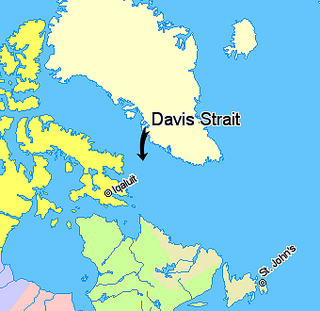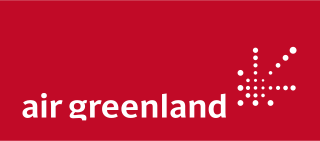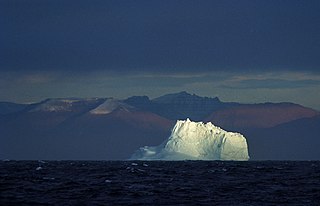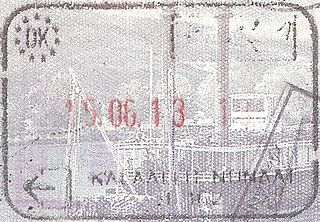See also
Years in North America | |
|---|---|
| Sovereign states | |
Dependencies and other territories | |
| |||||||
| History | |||||||
| Geography | |||||||
| Politics | |||||||
| Economy | |||||||
| Society |
| ||||||
This is a list of the individual Greenland year pages.

Greenland is a North American autonomous territory of the Kingdom of Denmark. It is the larger of two autonomous territories within the Kingdom, the other being the Faroe Islands; the citizens of both territories are full citizens of Denmark. As Greenland is one of the Overseas Countries and Territories of the European Union, citizens of Greenland are European Union citizens. The capital and largest city of Greenland is Nuuk. Greenland lies between the Arctic and Atlantic oceans, east of the Canadian Arctic Archipelago. It is the world's largest island, and is the location of the northernmost area of the world – Kaffeklubben Island off the northern coast is the world's northernmost undisputed point of land, and Cape Morris Jesup on the mainland was thought to be so until the 1960s.
The politics of Greenland, an autonomous country within the Kingdom of Denmark, function in a framework of a parliamentary representative democratic dependency, whereby the prime minister is the head of government, and of a multi-party system. Executive power is exercised by the government. Legislative power is vested in both the government and parliament Inatsisartut. The judiciary is independent of the executive and the legislature. Greenland has full autonomy on most matters, except on policies and decisions affecting the region including negotiations with the devolved legislatures and the Folketing.

The history of Greenland is a history of life under extreme Arctic conditions: currently, an ice sheet covers about eighty percent of the island, restricting human activity largely to the coasts.

Nuuk is the capital of and most populous city in Greenland, an autonomous territory in the Kingdom of Denmark. Nuuk is the seat of government and the territory's largest cultural and economic center. The major cities from other countries closest to the capital are Iqaluit and St. John's in Canada and Reykjavík in Iceland. Nuuk contains a third of Greenland's population and its tallest building. Nuuk is also the seat of government for the Sermersooq municipality. In January 2023, it had a population of 19,604. Nuuk is considered a modernized city after the policy began in 1950.

Erik Thorvaldsson, known as Erik the Red, was a Norse explorer, described in medieval and Icelandic saga sources as having founded the first European settlement in Greenland. Erik most likely earned the epithet "the Red" due to the color of his hair and beard. According to Icelandic sagas, Erik was born in the Jæren district of Rogaland, Norway, as the son of Thorvald Asvaldsson; to which Thorvald would later be banished from Norway, and would sail west to Iceland with Erik and his family. During Erik's life in Iceland, he married Þjódhild Jorundsdottir and would have four children, with one of Erik's sons being the well-known Icelandic explorer Leif Erikson. Around the year of 982, Erik was exiled from Iceland for three years, during which time he explored Greenland, eventually culminating in his founding of the first successful European settlement on the island. Erik would later die there around 1003 CE during a winter epidemic.

The Norse exploration of North America began in the late 10th century, when Norsemen explored areas of the North Atlantic colonizing Greenland and creating a short term settlement near the northern tip of Newfoundland. This is known now as L'Anse aux Meadows where the remains of buildings were found in 1960 dating to approximately 1,000 years ago. This discovery helped reignite archaeological exploration for the Norse in the North Atlantic. This single settlement, located on the island of Newfoundland and not on the North American mainland, was abruptly abandoned.

Davis Strait is a southern arm of the Arctic Ocean that lies north of the Labrador Sea. It lies between mid-western Greenland and Baffin Island in Nunavut, Canada. To the north is Baffin Bay. The strait was named for the English explorer John Davis (1550–1605), who explored the area while seeking a Northwest Passage. By the 1650s it was used for whale hunting.

The Greenland ice sheet is an ice sheet about 1.67 km (1.0 mi) thick on average, and almost 3.5 km (2.2 mi) at its thickest point. It is almost 2,900 kilometres (1,800 mi) long in a north–south direction, with the greatest width of 1,100 kilometres (680 mi) at a latitude of 77°N, near its northern edge. It covers 1,710,000 square kilometres (660,000 sq mi), around 80% of the surface of Greenland, and is the second largest body of ice in the world, after the East Antarctic ice sheet. The acronyms GIS or GrIS are also frequently used in the scientific literature.

Air Greenland A/S, also known as Greenlandair, is the flag carrier of Greenland, owned by the Greenlandic Government. It operates a fleet of 28 aircraft, including 2 airliners used for transatlantic and charter flights, 8 fixed-wing aircraft primarily serving the domestic network, and 18 helicopters feeding passengers from the smaller communities into the domestic airport network. Flights to heliports in the remote settlements are operated on contract with the government of Greenland.

The Greenland Sea is a body of water that borders Greenland to the west, the Svalbard archipelago to the east, Fram Strait and the Arctic Ocean to the north, and the Norwegian Sea and Iceland to the south. The Greenland Sea is often defined as part of the Arctic Ocean, sometimes as part of the Atlantic Ocean. However, definitions of the Arctic Ocean and its seas tend to be imprecise or arbitrary. In general usage the term "Arctic Ocean" would exclude the Greenland Sea. In oceanographic studies the Greenland Sea is considered part of the Nordic Seas, along with the Norwegian Sea. The Nordic Seas are the main connection between the Arctic and Atlantic oceans and, as such, could be of great significance in a possible shutdown of thermohaline circulation. In oceanography the Arctic Ocean and Nordic Seas are often referred to collectively as the "Arctic Mediterranean Sea", a marginal sea of the Atlantic.

The Greenland shark, also known as the gurry shark or grey shark, is a large shark of the family Somniosidae, closely related to the Pacific and southern sleeper sharks. The Greenland shark is a potentially important yet poorly studied cold-water species inhabiting the North Atlantic and Arctic Oceans.
Greenland is divided into five municipalities – Avannaata, Kujalleq, Qeqertalik, Qeqqata, and Sermersooq – as well as the large Northeast Greenland National Park which is unincorporated. The Pituffik Space Base is administered by the United States Space Force and operates as an unincorporated enclave surrounded by territory of Avannaata.

Greenland, an autonomous territory within the Kingdom of Denmark is one of the EU members’ overseas countries and territories (OCT) associated to the European Union. Greenland receives funding from the EU for sustainable development and has signed agreements increasing cooperation with the EU.

The Danish Realm, officially the Kingdom of Denmark, is the area over which the monarch of Denmark is head of state. It consists of metropolitan Denmark—the kingdom's territory in continental Europe and sometimes called "Denmark proper" —and the realm's two autonomous regions: the Faroe Islands in North Atlantic and Greenland in North America. The relationship between the three parts of the Kingdom is also known as The unity of the Realm.

Greenlandic cuisine is traditionally based on meat from marine mammals, birds, and fish, and normally contains high levels of protein. Since colonization and the arrival of international trade, the cuisine has been increasingly influenced by Danish, British, American and Canadian cuisine. During the summer when the weather is milder, meals are often eaten outdoors.

The Greenlandic Inuit are the indigenous and most populous ethnic group in Greenland. Most speak Greenlandic and consider themselves ethnically Greenlandic. People of Greenland are citizens of Denmark.

Greenlandic independence is a political ambition of some political parties, advocacy groups, and individuals of Greenland, an autonomous territory within the Kingdom of Denmark, to become an independent sovereign state.

After being a part of the European Communities (EC) for twelve years, Greenland withdrew in 1985. It had joined the EC in 1973 as a county of Denmark, even though a majority in Greenland was against joining. In a consultative referendum in 1982, 53% of the electorate of Greenland voted to withdraw from the Communities. This latter referendum became possible after the introduction of home rule in Greenland in 1979. Following its withdrawal, which was regulated through the Greenland Treaty, the relationship between Greenland and the EC was partly settled through an association under Overseas Countries and territories (OCT) status. In recent years, the Greenlandic withdrawal from the European Communities has marginally been referred to as "Greenxit".

The visa policy of Greenland consists of the requirements for foreign nationals to enter and remain in Greenland.

The COVID-19 pandemic in Greenland was a part of the ongoing worldwide pandemic of coronavirus disease 2019 caused by severe acute respiratory syndrome coronavirus 2. The virus was confirmed to have spread to Greenland, an autonomous territory of the Kingdom of Denmark, in March 2020. As of 27 May 2020, there had been 13 confirmed cases, but none were in need of hospitalization. Among the first 11, the last infected person had recovered on 8 April 2020, and after that, Greenland has had no known active cases. After a period of time without any new confirmed cases, one was confirmed on 24 May when a person tested positive at the entry into the territory, and another was confirmed at entry on 27 May 2020.